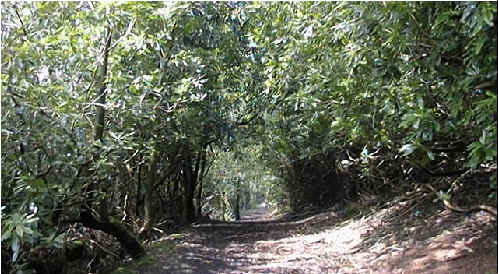Woodland Restoration Project
INTRODUCTION
| The Woodland Project commenced in November 1998 to clear dense
rhododendron undergrowth from an area of woodland in The Woodland Education Centre in
Offwell. The overall aim of the project is to promote subsequent natural regeneration
through proactive management and to facilitate an increase in biodiversity in the area as
a result of the clearance. The project is part of an on-going program of restoration of The Woodland Education Centre, which was initiated in 1986. At that time, the Centre was covered in virtually worthless rhododendron jungle. Rhododendron (Rhododendron ponticum) is an introduced species. It does not support any fauna as it is toxic to our native plant-eating insects. The leaf litter is also toxic and slow to decay. The ability of other organisms to survive in the ground layer under rhododendron, is limited both by the toxicity of the leaf litter and by the extremely low level of light which filters through the extensive rhododendron canopy. Rhododendron grows very rapidly. Unchecked growth eventually results in an ecologically sterile habitat, with very little in the way of other vegetation or associated fauna.
Large areas of the Centre have now been cleared of rhododendron and restored to native habitats. However, some areas still remain. The Woodland Project will remove a significant remaining area of rhododendron in the northeast region of the Centre. Underlying leaf litter will also be raked off and removed. Any subsequent regeneration of rhododendron will be controlled and there will be some replanting of native species. The project is funded through the Landfill Tax Credit Scheme, with Devon County Council as the Landfill Tax Operator. Three surveys will be carried out during the course of the project. This, the first, will record vegetation prior to clearance. It will act as a baseline against which future increases in diversity of the ground flora can be measured. The second will be conducted once clearance has been completed, and the third a year later. |

